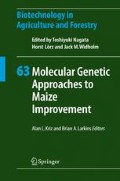One of the ultimate goals of biotechnology is to design beneficial phenotypes and then achieve them by altering gene expression. For any given organism that is a target of biotechnological improvement, an indexed collection of every single base change that created either a non-silent missense mutation or a truncated gene product would be ideal. Such a collection would provide the most flexibility in design of new varieties. While the number of mutant lines for such an idealized scenario is prohibitive, lines with a high density of point mutations can provide the starting material for a similar sort of approach.
The two greatest sources of point mutations are spontaneous mutation and chemical mutagenesis. Both of these sources rely on altering bases in DNA and then allowing the DNA replication system to use the altered base as a template, creating the mutation. In maize, where mutagenesis of pollen is quite straightforward (Neuffer 1994), this has been the method of choice for several decades, primarily because it avoids the creation of chimaeric plants that may or may not transmit induced mutations to progeny. To avoid lysis of the pollen by aqueous solutions, an emulsion of the mutagen is made in paraffin oil, and the pollen mixed in.
Access this chapter
Tax calculation will be finalised at checkout
Purchases are for personal use only
Preview
Unable to display preview. Download preview PDF.
References
Comai L, Young K, Till BJ, Reynolds SH, Greene EA, Codomo CA, Enns LC, Johnson JE, Burtner C, Odden AR, Henikoff S (2004) Efficient discovery of DNA polymorphisms in natural populations by ecotilling. Plant J 37:778–786
Consortium E (2007) Identification and analysis of functional elements in 1% of the human genome by the ENCODE pilot project. Nature 447:799–816
Cordeiro G, Eliott FG, Henry RJ (2006) An optimized ecotilling protocol for polyploids or pooled samples using a capillary electrophoresis system. Anal Biochem 355:145–147
Liu K, Goodman M, Muse S, Smith JS, Buckler E, Doebley J (2003) Genetic structure and diversity among maize inbred lines as inferred from DNA microsatellites. Genetics 165:2117–2128
McCallum CM, Comai L, Greene EA, Henikoff S (2000) Targeting induced local lesions in genomes (TILLING) for plant functional genomics. Plant Physiol 123:439–442
Neuffer MG (1994) Mutagenesis. In: Freeling M, Walbot V (eds) The maize handbook. Springer, New York, pp 212–219
Neuffer MG, Coe EH Jr (1978) Paraffin oil technique for treating mature corn pollen with chemical mutagens. Maydica 23:21–28
Ng PC, Henikoff S (2003) SIFT: predicting amino acid changes that affect protein function. Nucleic Acids Res 31:3812–3814
Perry JA, Wang TL, Welham TJ, Gardner S, Pike JM, Yoshida S, Parniske M (2003) A TILLING reverse genetics tool and a web-accessible collection of mutants of the legume Lotus japonicus. Plant Physiol 131:866–871
Schreiber DN, Dresselhaus T (2003) In vitro pollen germination and transient transformation of Zea mays and other plant species. Plant Molec Biol Rep 21:31–41
Shendure J, Mitra RD, Varma C, Church GM (2004) Advanced sequencing technologies: methods and goals. Nat Rev Genet 5:335–344
Shendure J, Porreca GJ, Reppas NB, Lin X, McCutcheon JP, Rosenbaum AM, Wang MD, Zhang K, Mitra RD, Church GM (2005) Accurate multiplex polony sequencing of an evolved bacterial genome. Science 309:1728–1732
Slade AJ, Fuerstenberg SI, Loeffler D, Steine MN, Facciotti D (2005) A reverse genetic, nontransgenic approach to wheat crop improvement by TILLING. Nat Biotechnol 23:75–81
Till BJ, Reynolds SH, Greene EA, Codomo CA, Enns LC, Johnson JE, Burtner C, Odden AR, Young K, Taylor NE, Henikoff JG, Comai L, Henikoff S (2003) Large-scale discovery of induced point mutations with high-throughput TILLING. Genome Res 13:524–530
Till BJ, Burtner C, Comai L, Henikoff S (2004a) Mismatch cleavage by single-strand specific nucleases. Nucleic Acids Res 32:2632–2641
Till BJ, Reynolds SH, Weil C, Springer N, Burtner C, Young K, Bowers E, Codomo CA, Enns LC, Odden AR, Greene EA, Comai L, Henikoff S (2004b) Discovery of induced point mutations in maize genes by TILLING. BMC Plant Biol 4:12
Weil CF, Monde R, Till B, Comai L, Henikoff S (2005) Mutagenesis and functional genomics in maize. Maydica 50:415–424
Weil CF, Monde R-A (2007) Getting the point: mutations in maize. Crop Sci 47:S60–S67
Author information
Authors and Affiliations
Corresponding author
Editor information
Editors and Affiliations
Rights and permissions
Copyright information
© 2009 Springer Science+Business Media, B.V
About this chapter
Cite this chapter
Weil, C.F., Monde, RA. (2009). EMS Mutagenesis and Point Mutation Discovery. In: Kriz, A.L., Larkins, B.A. (eds) Molecular Genetic Approaches to Maize Improvement. Biotechnology in Agriculture and Forestry, vol 63. Springer, Berlin, Heidelberg. https://doi.org/10.1007/978-3-540-68922-5_12
Download citation
DOI: https://doi.org/10.1007/978-3-540-68922-5_12
Publisher Name: Springer, Berlin, Heidelberg
Print ISBN: 978-3-540-68919-5
Online ISBN: 978-3-540-68922-5
eBook Packages: Biomedical and Life SciencesBiomedical and Life Sciences (R0)

